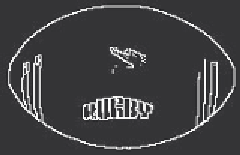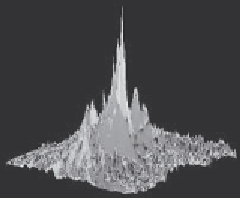Image Processing Reference
In-Depth Information
(a) Ellipse
(b) Rugby ball edges
(c) Noisy rugby ball edges
(d) Accumulator for (a)
(e) Accumulator for (b)
(f) Accumulator for (c)
Figure 5.14
Applying the Hough transform for ellipses
it still requires significant computational resources. In the previous sections, we saw that
as we increase the complexity of the curve under detection, the computational requirements
increase in an exponential way. Thus, the HT becomes less practical. For this reason, most
of the research in the HT has focused on the development of techniques aimed to reduce
its computational complexity (Illingworth, 1988), (Leavers, 1993). One important way to
reduce the computation has been the use of geometric properties of shapes to decompose
the parameter space. Several techniques have used different geometric properties. These
geometric properties are generally defined by the relationship between points and derivatives.
5.4.5.1 Parameter space reduction for lines
For a line, the accumulator space can be reduced from 2D to 1D by considering that we can
compute the slope from the information of the image. The slope can be computed either by
using the
gradient direction
at a point or by considering a pair of points. That is
yy
xx
-
-
2
1
m
=
or
m
=
(5.38)
2
1
where ϕ is the gradient direction at the point. In the case of take two points, by considering
Equation 5.24 we have that,
xy xy
xx
-
-
21
12
c
=
(5.39)
2
1
Thus, according to Equation 5.29 we have that one of the parameters of the polar representation
for lines, θ
, is now given by
xx
yy
-
-
1
-1
-1
1
2
= - tan
or = tan
(5.40)
2
1


























